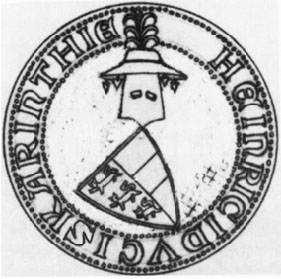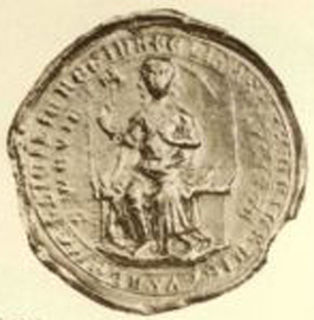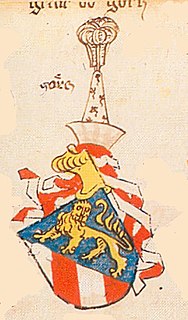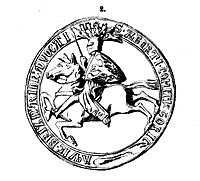Biography
Albert was the younger son of Count Meinhard III of Gorizia, who had married Adelaide, daughter of Count Albert IV of Tyrol. As his father-in-law left no male heirs when he died in 1253, Count Meinhard III was able to unite the Gorizia and Tyrolean lands under his rule.
Reigning as Meinhard I of Gorizia-Tyrol, Albert's father, however, also had entered a fierce quarrel with the Sponheim duke Bernhard of Carinthia and his son, Archbishop-elect Philip of Salzburg. Defeated by the united Carinthian and Salzburg forces, Meinhard's sons, young Albert and his elder brother Meinhard IV, from 1253 were held hostage by the Salzburg archbishop at Hohenwerfen Castle. Count Meinhard died in 1258; his sons, finally released in 1262, went on to rule their Gorizia-Tyrol heritage. In 1267 Albert participated in an expedition against the advancing Venice forces in the March of Istria alongside the Aquileia patriarch Gregorio di Montelongo, but later had him kidnapped sparking a long-time conflict.
In 1271, after a lengthy inheritance dispute, Albert finally split his father's heirloom of Gorizia-Tyrol with his elder brother Meinhard. He received the County of Gorizia, i.e. the family's estates around Gorizia in the former March of Friuli, in Istria and Carniola, as well as in the Tyrolean Puster Valley up to Lienz, while Meinhard went on to rule as Count of Tyrol. While the Tyrolean branch of the Meinhardiner dynasty became extinct in the male line upon the death of Meinhard's son Henry in 1335, Albert's descendants ruled Gorizia until the death of Count Leonhard in 1500.
In the war for Capodistria (1274-1279), Albert again sided for Patriarch Raimondo della Torre against Venice, receiving the fortress of Cormons in exchange. When in 1275 the armed conflict of King Ottokar II of Bohemia against the newly elected Habsburg king Rudolf I of Germany broke out, Albert invaded Ottokar's lands in Carniola and the Windic March, while his brother Meinhard occupied Carinthia; later they both invaded the Duchy of Styria (1276). The conflict ended with confiscation of Ottokar's possessions by King Rudolf, although the war later resumed, ending with the death of Ottokar in the 1278 Battle on the Marchfeld. In reward of their support, Albert's brother Meinhard was enfeoffed with the Duchy of Carinthia in 1286.
In 1283 Albert and Patriarch Raimondo were again allied against Venice, this time in the war for Trieste; however, in 1289, after an unsuccessful attack against the Romagna fort in April 1289, he signed a separate peace with the Venetians.

Henry, a member of the House of Gorizia (Meinhardiner), was Duke of Carinthia and Landgrave of Carniola and Count of Tyrol from 1295 until his death, as well as King of Bohemia, Margrave of Moravia and titular King of Poland in 1306 and again from 1307 until 1310. After his death, the Habsburgs took over Carinthia and Carniola, and held them almost without interruption until 1918.

Margaret, nicknamed Margarete Maultasch, was the last Countess of Tyrol from the House of Gorizia (Meinhardiner), and an unsuccessful claimant to the Duchy of Carinthia. Upon her death, Tyrol became united with the Austrian hereditary lands of the Habsburg dynasty.

Meinhard II, a member of the House of Gorizia (Meinhardiner), ruled the County of Gorizia and the County of Tyrol together with his younger brother Albert from 1258, until in 1271 they divided their heritage and Meinhard became sole ruler of Tyrol. In 1286 he was enfeoffed with the Duchy of Carinthia and the adjacent March of Carniola.

Meinhard I, a member of the House of Gorizia (Meinhardiner), was Count of Gorizia from 1231 and Count of Tyrol from 1253 until his death.

Meinhard III, a member of the House of Wittelsbach, was duke of Upper Bavaria and count of Tyrol from 1361 until his death. He was the son of Duke Louis V of Bavaria with Countess Margaret of Tyrol and as such also the last descendant of the Tyrolean branch of the House of Gorizia.

The (Princely) County of Tyrol was an estate of the Holy Roman Empire established about 1140. Originally a jurisdiction under the sovereignty of the Counts of Tyrol, it was inherited by the Counts of Gorizia in 1253 and finally fell to the Austrian House of Habsburg in 1363. In 1804 the Princely County of Tyrol, unified with the secularised Prince-Bishoprics of Trent and Brixen, became a crown land of the Austrian Empire in 1804 and from 1867 a Cisleithanian crown land of Austria-Hungary.

The County of Gorizia, from 1365 Princely County of Gorizia, was a State of the Holy Roman Empire. Originally mediate Vogts of the Patriarchs of Aquileia, the Counts of Gorizia (Meinhardiner) ruled over several fiefs in the area of Lienz and in the Friuli region of northeastern Italy with their residence at Gorizia (Görz).

The Counts of Gorizia, or Meinhardiner, were a comital and ducal dynasty in the Holy Roman Empire. Named after the Gorizia Castle, they were originally advocates (vogts) in the Patriarchate of Aquileia who ruled the County of Gorizia (Görz) from the early 12th century until the year 1500. Staunch supporters of the Emperors against the papacy, they reached the height of their power in the aftermath of the battle of Marchfeld between the 1280s and 1310s, when they controlled most of contemporary Slovenia, western and south-western Austria and north-eastern Italy. After 1335, they began a steady decline until their territories shrunk back to the original County of Gorizia by the mid 1370s. Their remaining lands were inherited by the Habsburg ruler Maximilian I.

The Marchof Carniola was a southeastern state of the Holy Roman Empire in the High Middle Ages, the predecessor of the Duchy of Carniola. It corresponded roughly to the central Carniolan region of present-day Slovenia. At the time of its creation, the march served as a frontier defense against the Kingdoms of Hungary and Croatia.

Elisabeth of Bavaria, a member of the House of Wittelsbach, was Queen consort of Germany from 1246 to 1254 by her marriage to King Conrad IV of Germany.

The Counts of Ortenburg were a comital family in the mediaeval Duchy of Carinthia. Though they had roots in Bavarian nobility, an affiliation with the Imperial Counts of Ortenburg, a branch line of the Rhenish Franconian House of Sponheim, is not established.

Leonhard of Gorizia was the last Count of Görz from the Meinhardiner dynasty, who ruled at Lienz and Gorizia (Görz) from 1454 until his death.

Otto III, a member of the House of Gorizia, was Duke of Carinthia and Count of Tyrol from 1295 until his death. He ruled jointly with his younger brothers Louis and Henry VI.

Meinhard VI of Gorizia a member of the Meinhardiner dynasty, an imperial prince and a count of Gorizia.

Albert II, a member of the House of Gorizia, ruled as governor of the County of Gorizia from 1323, on behalf of his nephew Count John Henry IV. He inherited from his father only the lands in the Puster Valley.

Albert III (1338-1365), a member of the House of Gorizia, ruled as Count of Gorizia from 1338 until his death.

Henry III, Count of Gorizia (1263-1323) was a member of the Meinhardiner dynasty.
Henry, Count of Pfannberg was a Count of Pfannberg. He was the Governor of Styria from 1253 to 1254 and high judge of Styria from 1276 to 1279.

Meinhard I, an ancestor of the noble House of Gorizia, was ruling count of Gorizia from 1122 until his death. He also held the offices of a Count palatine in the Duchy of Carinthia as well as Vogt governor of the Patriarchate of Aquileia and of St Peter Abbey in the March of Istria.

Philip of Spanheim was elected Archbishop of Salzburg (1247–1257) and Patriarch of Aquileia (1269–1271). He held the title of a Count of Lebenau (1254–1279) and was nominal Duke of Carinthia. With his death the senior line of the House of Sponheim came to an end.
















